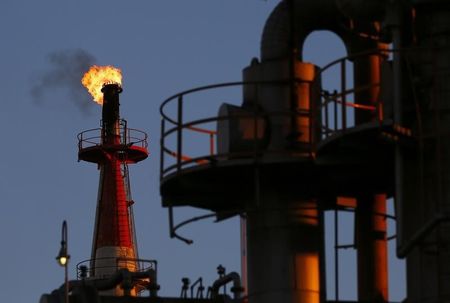Commodities
Oil prices settle higher on signs of improving China economy; US CPI looms

Investing.com– Oil prices settled higher Monday, as signs of an improving economy in China boosted demand hopes at time when wildfires in China threaten supplies.
AT 14.30 ET (19:30 GMT), climbed 0.5%, to $83.21 a barrel, while U.S. West Texas Intermediate crude futures rose 0.8%, to settle at $78.92 a barrel.
Chinese inflation data stokes global growth hopes
Chinese inflation data for April, released over the weekend, showed a sustained recovery in inflation, boosted hopes that demand and economy growth continued to recovery following substantial monetary support from Beijing.
China’s oil imports in April had fallen from the prior month, albeit slightly. They were also largely flat from the same period last year, as the country grapples with a sluggish post-COVID economic recovery.
Alberta wildfire could cut output
Helping the tone Monday was the news of an evacuation alert for Fort McMurray, Alberta, as an out-of-control fire rages southwest of the major Canadian oil town, making it among the first actions ahead of the wildfire season.
In 2016, a huge wildfire in Fort McMurray forced the evacuation of 90,000 residents and shut in more than a million barrels per day of oil output.
Global supply will remain an issue ahead of June’s meeting of the Organization of Petroleum Exporting Countries, and allies, a group of major producers known as OPEC+.
Goldman Sachs said last week, in a note, that it no longer expects OPEC+ to partially reverse recent voluntary production cuts next month, expecting Saudi Arabia’s crude oil supply to remain steady at 9 million barrels per day in July, compared to their earlier estimate of 9.2 million barrels per day.
remove ads
.
However, there were reports over the weekend that Iraq’s oil minister said that the country would not agree to further supply cuts, and it is not clear whether this refers to a rollover of existing cuts or deeper cuts.
Dollar unchanged ahead of US CPI inflation data
prices were also helped by a weakness in the dollar as investors awaited key inflation data this week, with the and due on Tuesday and Wednesday, respectively.
The data are set to arrive following a string of hotter-than-expected inflation reports in Q1 that forced investors to not only push out rate cut bets but reduce the number of cuts expected to just two for the year.
(Peter Nurse, Ambar Warrick contributed to this article.)
Commodities
Oil prices rise; U.S. crude inventories plunge, Russia-Ukraine truce eyed
Commodities
India’s Reliance to stop buying Venezuelan oil over US tariffs, sources say
Commodities
Oil prices climb on Venezuela supply worries

 Forex3 years ago
Forex3 years agoForex Today: the dollar is gaining strength amid gloomy sentiment at the start of the Fed’s week

 Forex3 years ago
Forex3 years agoUnbiased review of Pocket Option broker

 Forex3 years ago
Forex3 years agoDollar to pound sterling exchange rate today: Pound plummeted to its lowest since 1985

 Forex3 years ago
Forex3 years agoHow is the Australian dollar doing today?

 Cryptocurrency3 years ago
Cryptocurrency3 years agoWhat happened in the crypto market – current events today

 World3 years ago
World3 years agoWhy are modern video games an art form?

 Commodities3 years ago
Commodities3 years agoCopper continues to fall in price on expectations of lower demand in China

 Economy3 years ago
Economy3 years agoCrude oil tankers double in price due to EU anti-Russian sanctions























